Abstract
1. Thromboxane A2 (TP-) receptors in human, rat and rabbit platelets and in smooth muscle of guinea-pig trachea, rat aorta and rabbit aorta have been characterized by measurement of the potencies of agonists and antagonists having considerable variations in chemical structure. 2. On each washed platelet system, eight prostanoids induced maximal irreversible aggregation (full agonists) and the potency ranking was EP 171 > STA2 > 9,11-azo PGH2 > 9,11-endoxy-10a-homo PGH2 > U-46619 (standard) > PGH2 = 16-p-fluorophenoxy-omega-tetranor PGF2 alpha > 16,16-dimethyl PGF2 alpha. Correlations between the three platelet preparations for both absolute and relative potencies were good. On human platelets, STA2, at concentrations above that required for maximum aggregation, exerted an inhibitory effect which was independent of its interaction with the TP-receptor. 3. Five prostanoids, EP 109, EP 167, EP 204, PTA2 and 16,20-methano PTA2, exhibited partial agonist activity on the platelet and smooth muscle preparations. There was good agreement between absolute potencies on the six preparations; on platelets potency was assessed from shape change measurements, since aggregation, when present, always showed a very shallow concentration-response relationship. The magnitude of the maximum response induced by each compound decreased in the order listed above, to the extent that 16,20-methano PTA2 could be treated as a pure antagonist. 4. With U-46619 as agonist, the pA2 values of seven antagonists were found to be very similar on human and rat platelets. The potency ranking was EP 169 > AH 23848 > EP 092 > ONO 11120 > EP 115 = 16,20-methano PTA2 > BM 13177.(ABSTRACT TRUNCATED AT 250 WORDS)
Full text
PDF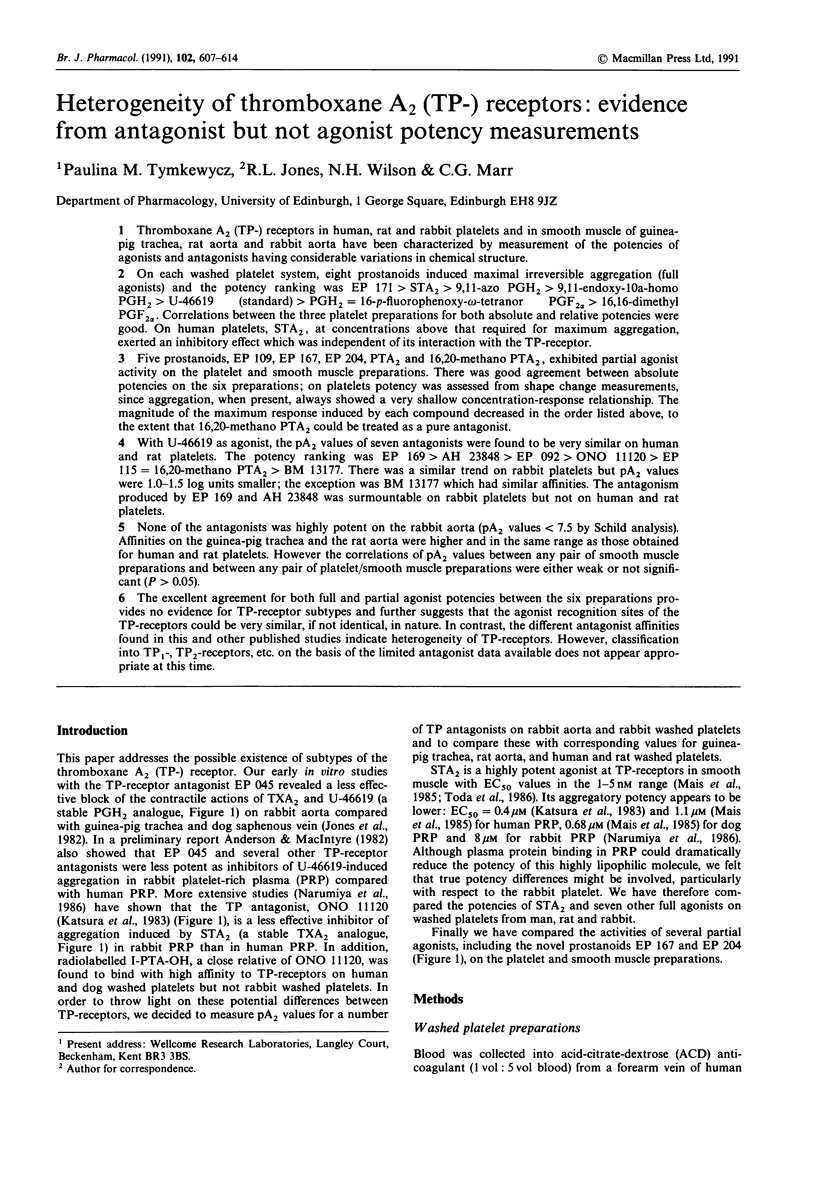
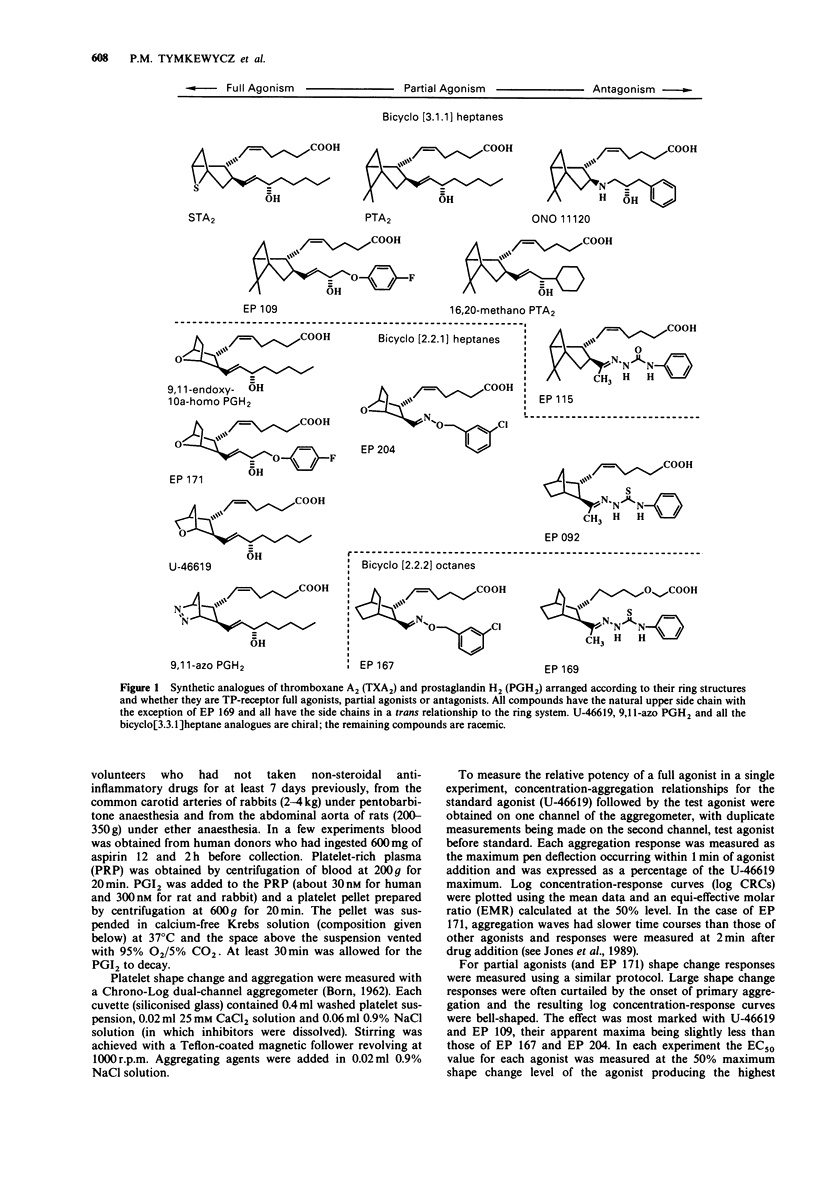
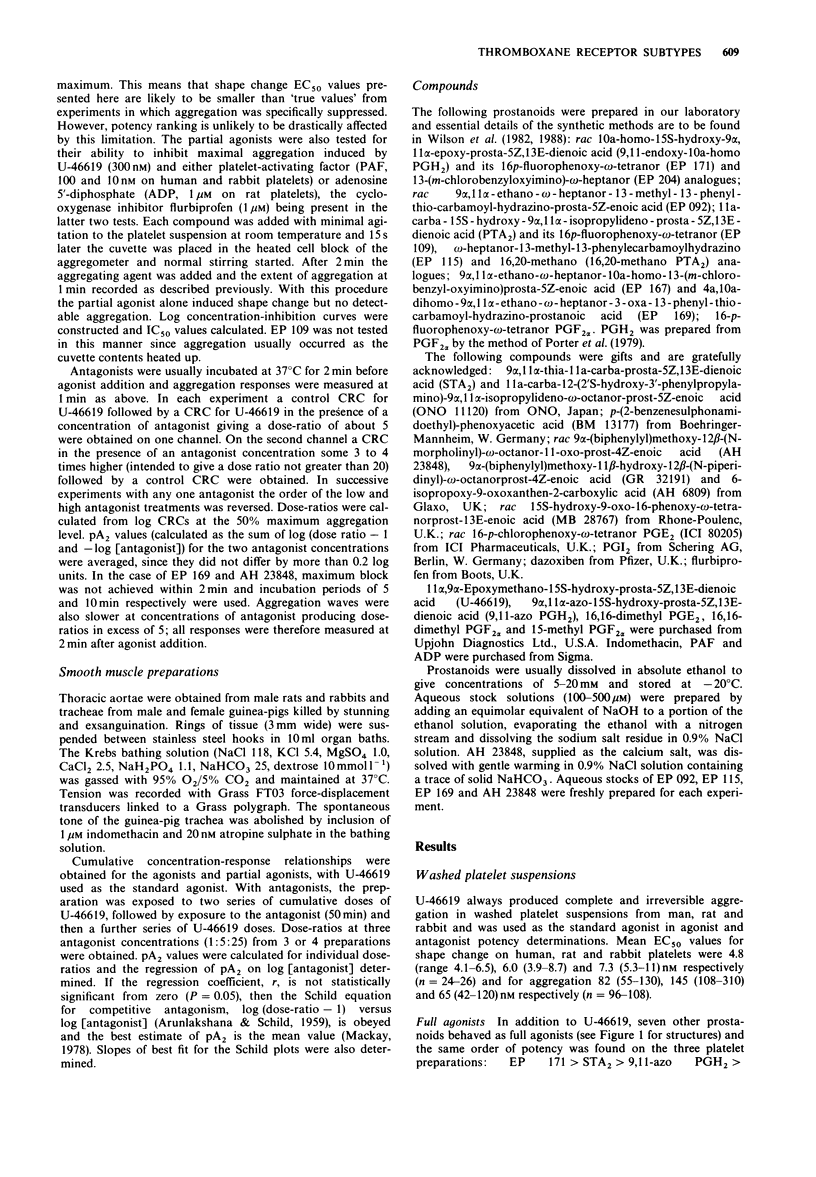
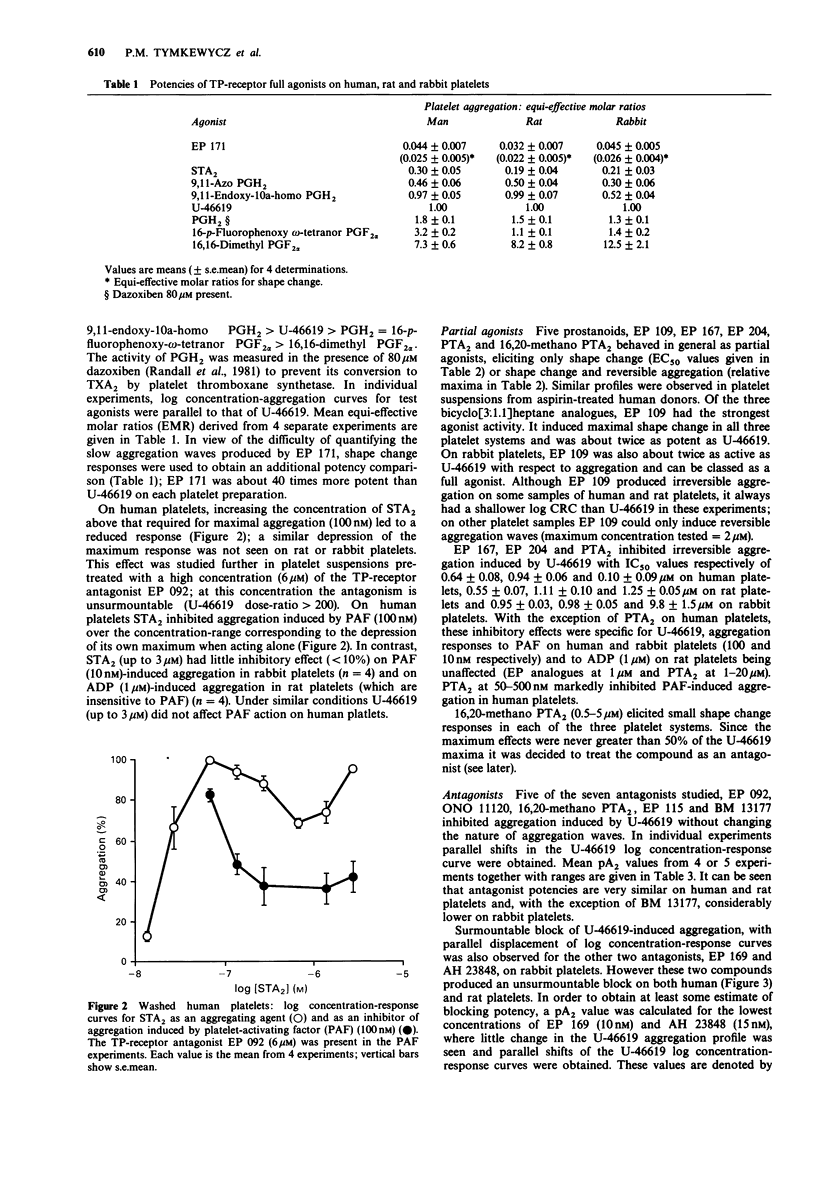
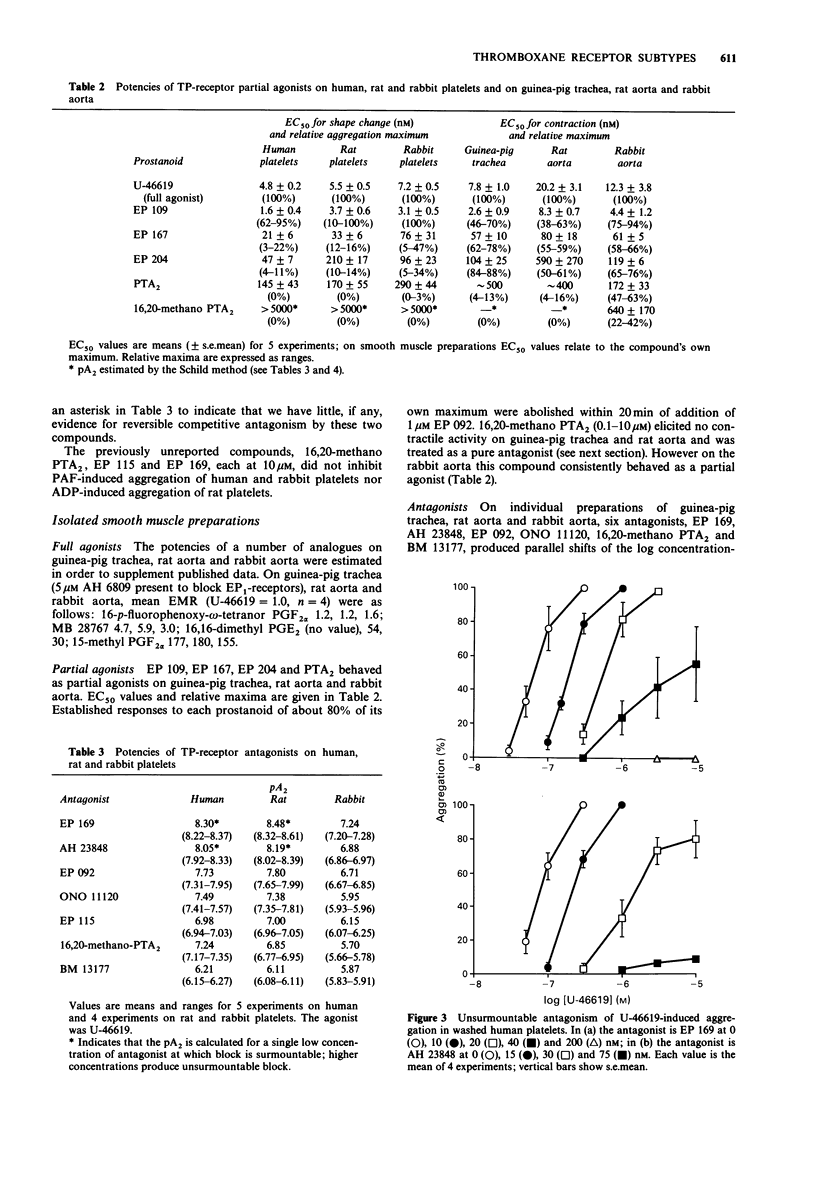
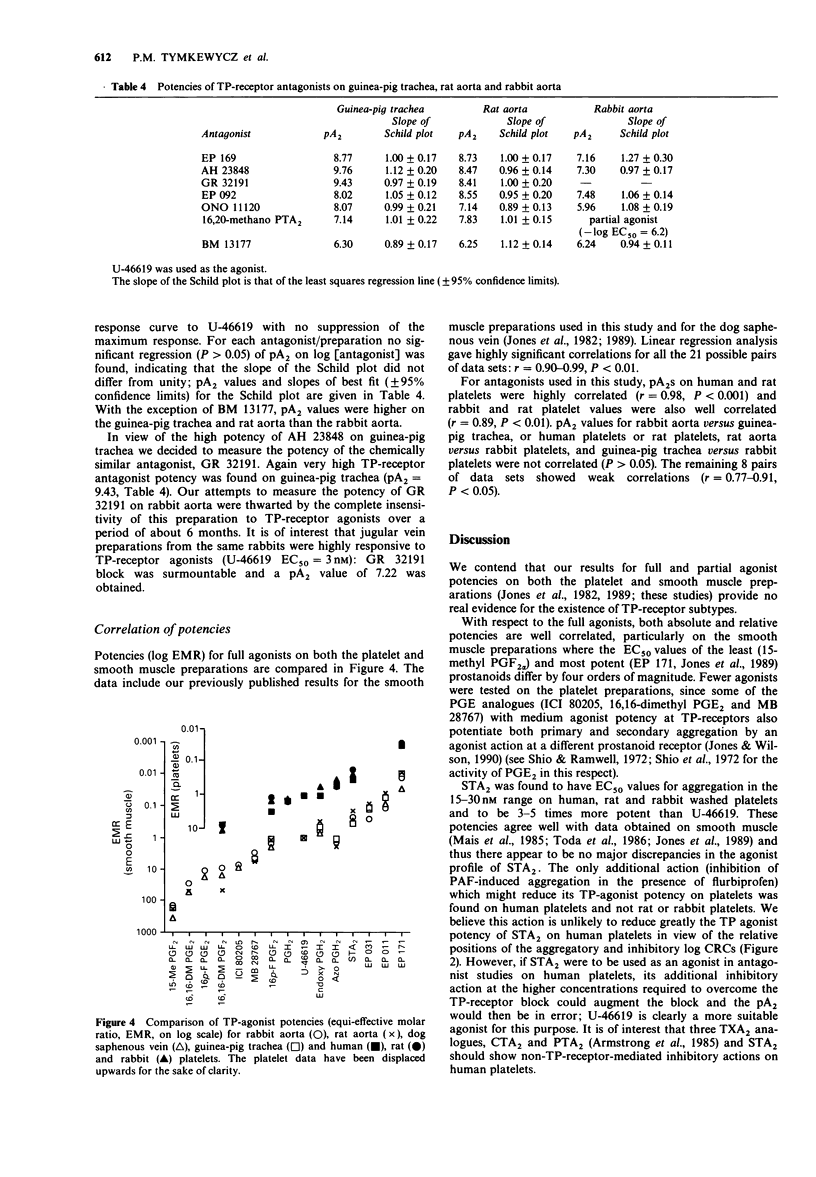
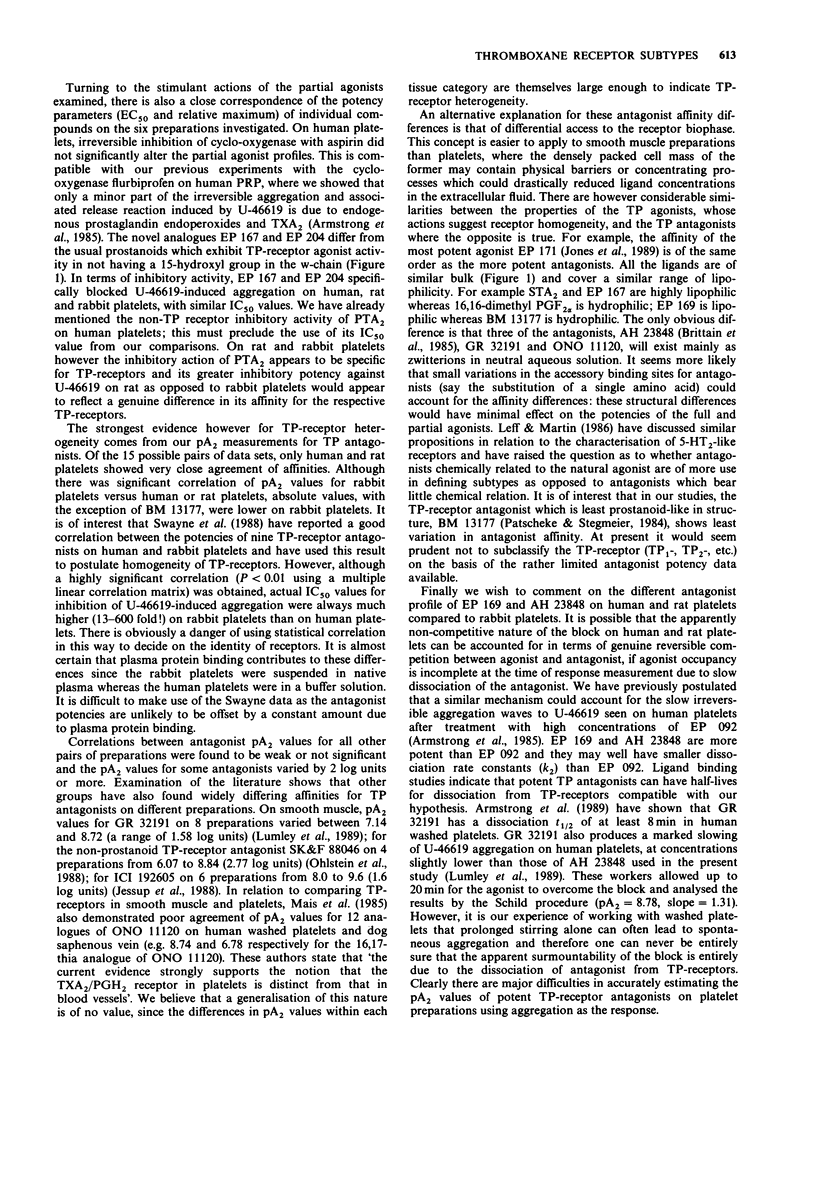
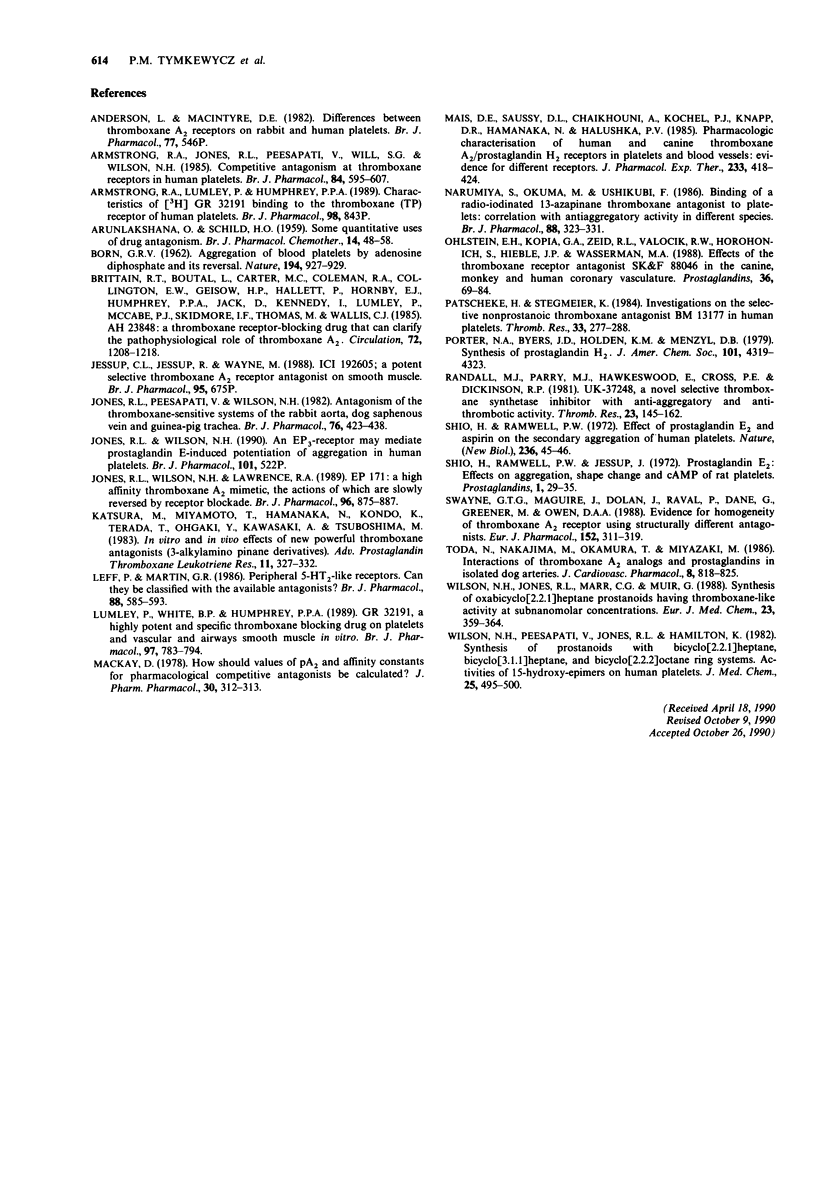
Selected References
These references are in PubMed. This may not be the complete list of references from this article.
- ARUNLAKSHANA O., SCHILD H. O. Some quantitative uses of drug antagonists. Br J Pharmacol Chemother. 1959 Mar;14(1):48–58. doi: 10.1111/j.1476-5381.1959.tb00928.x. [DOI] [PMC free article] [PubMed] [Google Scholar]
- Armstrong R. A., Jones R. L., Peesapati V., Will S. G., Wilson N. H. Competitive antagonism at thromboxane receptors in human platelets. Br J Pharmacol. 1985 Mar;84(3):595–607. doi: 10.1111/j.1476-5381.1985.tb16139.x. [DOI] [PMC free article] [PubMed] [Google Scholar]
- Armstrong R. A., Lumley P., Humphrey P. P. Characteristics of [3H]-GR 32191 binding to the thromboxane (TP) receptor of human platelets. Br J Pharmacol. 1989 Dec;98 (Suppl):843P–843P. [PubMed] [Google Scholar]
- BORN G. V. Aggregation of blood platelets by adenosine diphosphate and its reversal. Nature. 1962 Jun 9;194:927–929. doi: 10.1038/194927b0. [DOI] [PubMed] [Google Scholar]
- Brittain R. T., Boutal L., Carter M. C., Coleman R. A., Collington E. W., Geisow H. P., Hallett P., Hornby E. J., Humphrey P. P., Jack D. AH23848: a thromboxane receptor-blocking drug that can clarify the pathophysiologic role of thromboxane A2. Circulation. 1985 Dec;72(6):1208–1218. doi: 10.1161/01.cir.72.6.1208. [DOI] [PubMed] [Google Scholar]
- Jones R. L., Peesapati V., Wilson N. H. Antagonism of the thromboxane-sensitive contractile systems of the rabbit aorta, dog saphenous vein and guinea-pig trachea. Br J Pharmacol. 1982 Jul;76(3):423–438. doi: 10.1111/j.1476-5381.1982.tb09236.x. [DOI] [PMC free article] [PubMed] [Google Scholar]
- Jones R. L., Wilson N. H., Lawrence R. A. EP 171: a high affinity thromboxane A2-mimetic, the actions of which are slowly reversed by receptor blockade. Br J Pharmacol. 1989 Apr;96(4):875–887. doi: 10.1111/j.1476-5381.1989.tb11898.x. [DOI] [PMC free article] [PubMed] [Google Scholar]
- Leff P., Martin G. R. Peripheral 5-HT2-like receptors. Can they be classified with the available antagonists? Br J Pharmacol. 1986 Jul;88(3):585–593. doi: 10.1111/j.1476-5381.1986.tb10239.x. [DOI] [PMC free article] [PubMed] [Google Scholar]
- Lumley P., White B. P., Humphrey P. P. GR32191, a highly potent and specific thromboxane A2 receptor blocking drug on platelets and vascular and airways smooth muscle in vitro. Br J Pharmacol. 1989 Jul;97(3):783–794. doi: 10.1111/j.1476-5381.1989.tb12017.x. [DOI] [PMC free article] [PubMed] [Google Scholar]
- MacKay D. How should values of pA2 and affinity constants for pharmacological competitive antagonists be estimated? J Pharm Pharmacol. 1978 May;30(5):312–313. doi: 10.1111/j.2042-7158.1978.tb13237.x. [DOI] [PubMed] [Google Scholar]
- Mais D. E., Saussy D. L., Jr, Chaikhouni A., Kochel P. J., Knapp D. R., Hamanaka N., Halushka P. V. Pharmacologic characterization of human and canine thromboxane A2/prostaglandin H2 receptors in platelets and blood vessels: evidence for different receptors. J Pharmacol Exp Ther. 1985 May;233(2):418–424. [PubMed] [Google Scholar]
- Narumiya S., Okuma M., Ushikubi F. Binding of a radioiodinated 13-azapinane thromboxane antagonist to platelets: correlation with antiaggregatory activity in different species. Br J Pharmacol. 1986 Jun;88(2):323–331. doi: 10.1111/j.1476-5381.1986.tb10208.x. [DOI] [PMC free article] [PubMed] [Google Scholar]
- Ohlstein E. H., Kopia G. A., Zeid R. L., Valocik R. W., Horohonich S., Hieble J. P., Wasserman M. A. Effects of the thromboxane receptor antagonist SK&F 88046 in the canine, monkey and human coronary vasculature. Prostaglandins. 1988 Jul;36(1):69–84. doi: 10.1016/0090-6980(88)90103-7. [DOI] [PubMed] [Google Scholar]
- Patscheke H., Stegmeier K. Investigation on a selective non-prostanoic thromboxane antagonist, BM 13.177, in human platelets. Thromb Res. 1984 Feb 1;33(3):277–288. doi: 10.1016/0049-3848(84)90163-4. [DOI] [PubMed] [Google Scholar]
- Randall M. J., Parry M. J., Hawkeswood E., Cross P. E., Dickinson R. P. UK-37, 248, a novel, selective thromboxane synthetase inhibitor with platelet anti-aggregatory and anti-thrombotic activity. Thromb Res. 1981 Jul 1;23(1-2):145–162. doi: 10.1016/0049-3848(81)90247-4. [DOI] [PubMed] [Google Scholar]
- Shio H., Ramwell P. W., Jessup S. J. Prostaglandin E2: effects on aggregation, shape change and cyclic AMP of rat platelets. Prostaglandins. 1972 Jan;1(1):29–36. doi: 10.1016/0090-6980(72)90063-9. [DOI] [PubMed] [Google Scholar]
- Shio H., Ramwell P. Effect of prostaglandin E 2 and aspirin on the secondary aggregation of human platelets. Nat New Biol. 1972 Mar 15;236(63):45–46. doi: 10.1038/newbio236045a0. [DOI] [PubMed] [Google Scholar]
- Swayne G. T., Maguire J., Dolan J., Raval P., Dane G., Greener M., Owen D. A. Evidence for homogeneity of thromboxane A2 receptor using structurally different antagonists. Eur J Pharmacol. 1988 Aug 2;152(3):311–319. doi: 10.1016/0014-2999(88)90726-1. [DOI] [PubMed] [Google Scholar]
- Thijssen H. H., Baars L. G., Vervoort-Peters H. T. Vitamin K 2,3-epoxide reductase: the basis for stereoselectivity of 4-hydroxycoumarin anticoagulant activity. Br J Pharmacol. 1988 Nov;95(3):675–682. doi: 10.1111/j.1476-5381.1988.tb11692.x. [DOI] [PMC free article] [PubMed] [Google Scholar]
- Toda N., Nakajima M., Okamura T., Miyazaki M. Interactions of thromboxane A2 analogs and prostaglandins in isolated dog arteries. J Cardiovasc Pharmacol. 1986 Jul-Aug;8(4):818–825. doi: 10.1097/00005344-198709010-00025. [DOI] [PubMed] [Google Scholar]
- Wilson N. H., Peesapati V., Jones R. L., Hamilton K. Synthesis of prostanoids with bicyclo[2.2.1]heptane, bicyclo[3.1.1]heptane, and bicyclo[2.2.2]octane ring systems. Activities of 15-hydroxy epimers on human platelets. J Med Chem. 1982 May;25(5):495–500. doi: 10.1021/jm00347a004. [DOI] [PubMed] [Google Scholar]


